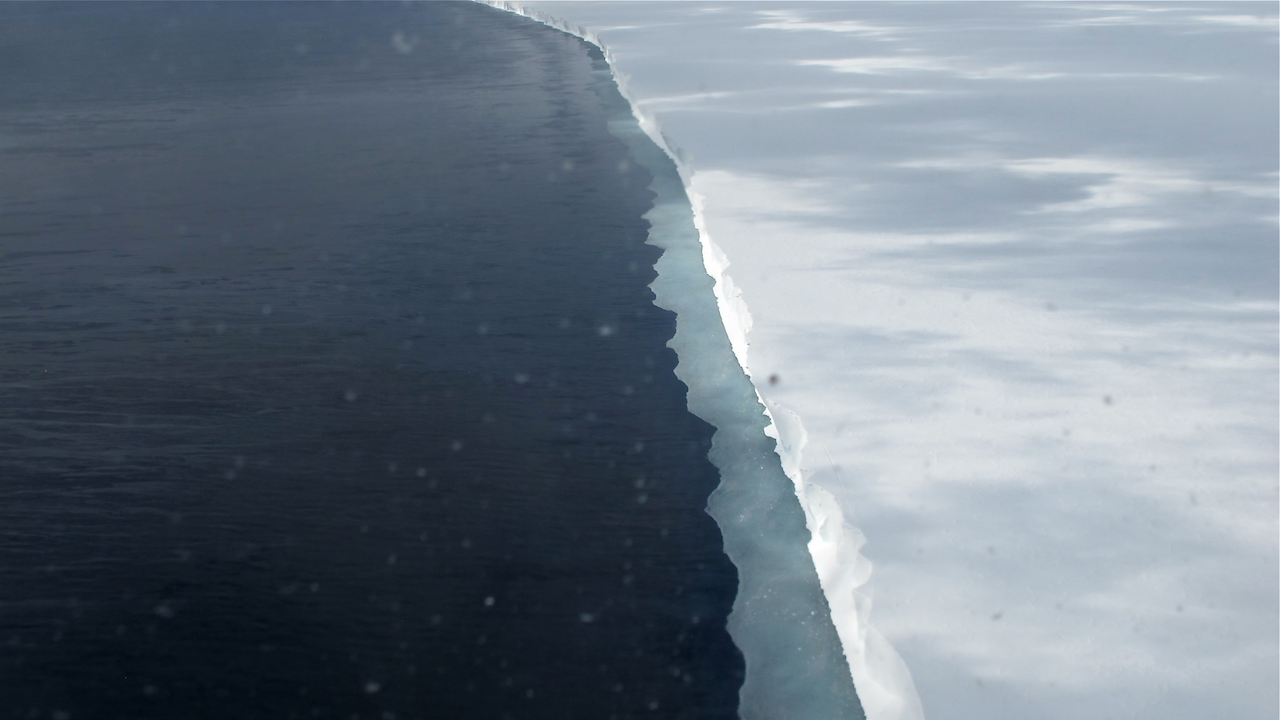News | September 18, 2023
How Ice-Shelf Loss Drives Sea Level Rise

The edge of the Ross Ice Shelf. Image credit: NASA/Jim Yungel
The question: What are ice-shelf calving and thinning, and what role do they play in Antarctic ice-shelf loss and sea level rise?
The answer: The Antarctic ice sheet contains enough ice to raise global mean sea level by 58 meters if it all melted. Every year, the sheet loses an average of 150 billion metric tons of ice.
Ice-shelf calving and thinning both contribute to the loss of ice-shelf mass but have different causes, said Nicole Schlegel, a National Oceanic and Atmospheric Administration physical scientist with the NASA Sea Level Change Team.
“When polar ocean temperatures rise, then you have thinning in those ice shelves, but you can have other things occur when the ice shelves are also affected by the atmosphere,” Schlegel said. “So, when you have more melting on the surface because the temperatures of the atmosphere are going up, in addition to the ocean-driven melting, then that can help create instabilities and cracks. And then you can have increased ice loss due to calving [when a portion of the ice shelf breaks away].”
But what do these processes have to do with sea level?
“Sea level change is an issue of ice sheet change,” said researcher Alex Gardner, also on the Sea Level Change Team. “You don’t get large changes in sea level unless you have changes in the ice sheets.”
From 2002 to 2017, ice sheets contributed a third of the total mean sea level rise, according to GRACE measurements.
Over the last 25 years, Antarctic ice shelves have lost about 6,000 gigatons of ice just through thinning, researchers have found. In the long run, thinning can lead to ice-sheet collapse, Gardner said.
“Once you start thinning the ice, you start to put more ice into the ocean,” he said. “That leads to more thinning and that leads to more loss, more thinning, more loss. And then all of a sudden, you can have the collapse of an entire ice sheet.”
Calving, meanwhile, can result in icebergs as large pieces of the ice shelf float away.
“The more icebergs that calve away, the less ice shelf area that you have to stabilize the ice sheet,” Schlegel said. “When you have increased melting from the ocean, you have thinning, and both of those cause ice from the ice shelves to be transported into the ocean.”
These processes can lead to potentially greater sea level rise.
“Thousands of meters of ice sit on land,” Schlegel said. “If the ice shelves are thinned or changed, then that decreases their ability to hold back the ice that’s on the land. More interior ice comes into the ocean, it speeds up, then you have a contribution to sea level rise.”
Why it’s important: In a study in Antarctica last year, JPL scientist Chad Greene, Gardner and Schlegel found a surprising result. They realized that several small calving events had been overlooked.
“We knew that the Ross and Ronne ice shelves calved massive icebergs as part of their normal cycles back in 2000 and 2002, and they’ve been growing back ever since then, just as expected,” Greene said. “But despite steady growth of Antarctica’s biggest ice shelves over the past two decades, the overall area of the ice sheet hasn’t gotten back up to where it was in 1997. That’s because the big gains that have been slowly happening from the largest ice shelves have been masking all of the minor losses that have occurred everywhere else around the continent.”
Adding up the ice previously unaccounted for, Greene found that it contributed to the loss of another 6,000 gigatons, doubling the amount lost to thinning over the past 25 years.
“It has implications for ecosystems that maybe have lived previously under ice shelves,” Greene said. “When you add 6,000 gigatons of freshwater into the ocean, it changes ocean circulation.”
One 2001 study on the Ronne’s neighboring Filchner ice shelf showed that calving events altered circulation in ocean currents by cutting the area off from sources of water with high saltiness.
Calving also causes changes to the Antarctic coastline. Previous studies reveal that retreating coastlines are linked to increased sea surface temperatures. As it warms, the water’s volume expands, leading to a rise in sea level.
To Gardner, all these calving and thinning events along the ice sheets appear to follow a pattern.
“We know that those large events happen periodically, and that’s a natural process,” Gardner said. “What nobody really looked into is overall, what is the whole thing doing?”
The team plans to study similar processes in Greenland, a hotspot for melting ice and sea level change.
